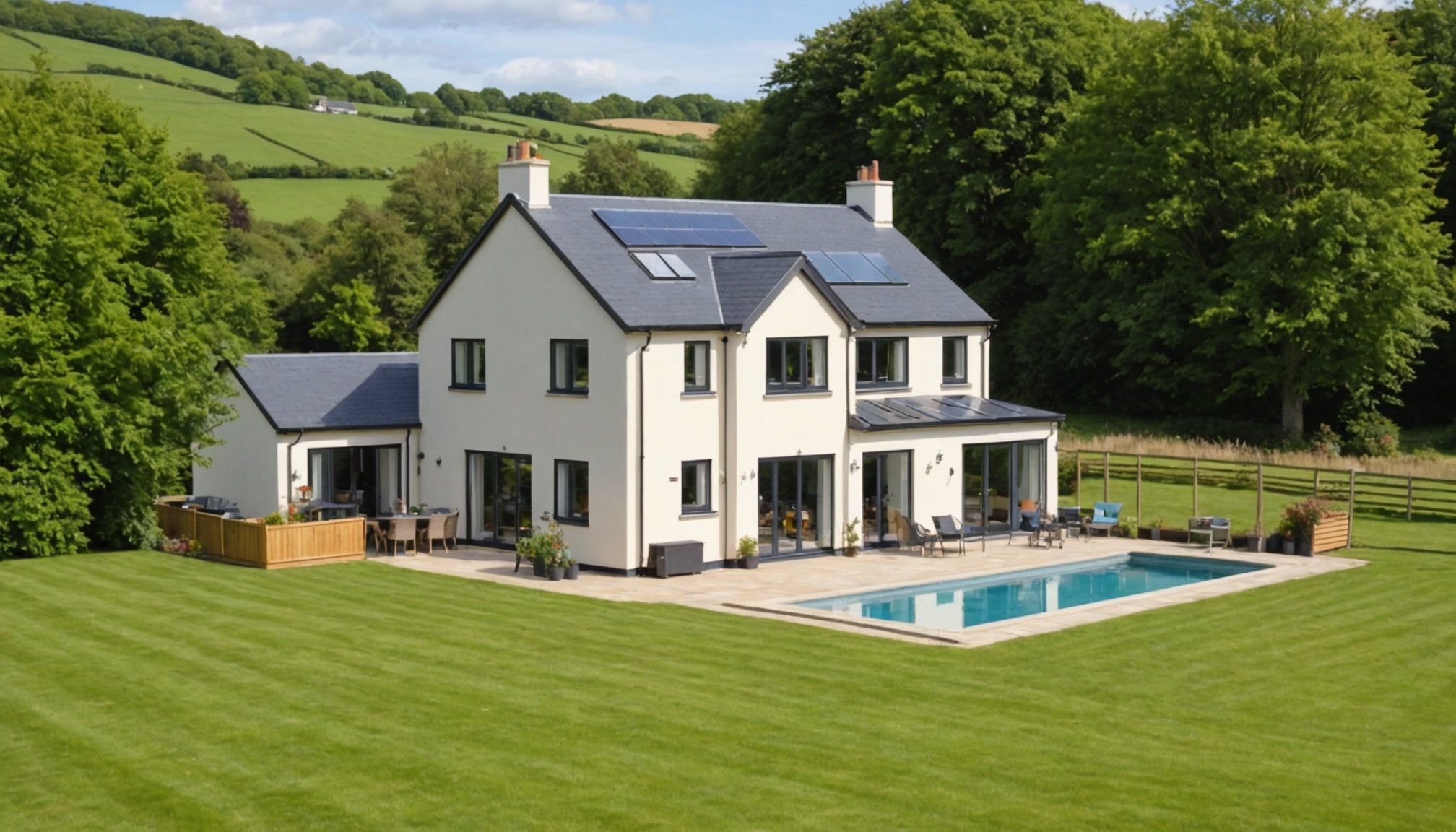Overview of Geothermal Heating Systems
Geothermal heating systems are a sophisticated solution harnessing the Earth’s natural heat. These systems work by circulating a fluid through underground pipes, absorbing the Earth’s stable temperatures and redistributing this heat into homes. This process leverages renewable energy by tapping into the consistent ground temperature, which remains relatively constant throughout the year, irrespective of surface weather conditions.
In the context of UK countryside homes, geothermal systems present notable benefits. These areas often feature expansive landscapes suitable for installing the necessary underground piping without the space limitations of urban settings. Additionally, geothermal heating integrates seamlessly with existing heating infrastructures, providing a practical retrofit option for traditional countryside residences seeking modern energy solutions.
A voir aussi : Transform Your UK Home with a Chic and Practical Mudroom Design
The energy efficiency of geothermal systems is particularly compelling. These systems reduce reliance on fossil fuels, thus curbing carbon emissions and contributing to environmental sustainability. Their efficiency is further exemplified by lower operational costs over time, as they require less energy input from external sources compared to conventional heating methods. Furthermore, geothermal systems offer a long lifespan with minimal maintenance, enhancing their appeal as a sustainable investment for homeowners prioritising eco-friendly living.
Understanding the Installation Process
Navigating the installation process of a geothermal heating system involves several critical phases. Foremost is the site analysis. This phase determines the suitability of your land, accounting for factors such as soil conditions and underground water sources. A thorough geothermal assessment follows, evaluating the area’s energy potential to ensure efficient system performance.
A lire aussi : Discovering the Best Strategies for Installing a Greywater Recycling System in Your UK Semi-Detached Home
Once the analysis is complete, the next step focuses on securing the necessary permits. This step is crucial for adhering to regulatory compliance in the UK. It involves obtaining permission from local authorities and meeting environmental regulations. Failure to comply with these requirements can result in fines or delays.
The installation steps typically unfold in a structured manner. Initially, boreholes are drilled into the ground, which will house the loop system responsible for transferring heat. After this, the heat pump and distribution systems are installed, ensuring efficient energy movement from the ground into your home.
Finally, a series of tests confirm the system’s operational efficiency and safety. Implementing these geothermal heating installation steps with precision is key to maximizing energy savings and environmental benefits. Understanding each phase underscores the importance of professional guidance to navigate this complex process successfully.
Preparing for Installation
Before beginning any installation project, thorough preparation is vital to ensure success.
Essential Materials
The first step in the preparing for installation process is identifying the essential materials necessary for the task. These materials should be appropriate for the scope of your project to avoid unnecessary delays. For instance, if you’re installing a flooring system, confirm that the type of flooring material, adhesive, and any underlayment are at hand. Using suitable materials is crucial for a seamless finish and long-term durability.
List of Tools Required
Having a detailed list of tools and equipment required is equally essential. This not only streamlines the process but also mitigates any potential setbacks. A standard toolkit might include:
- Power drill
- Spirit level
- Measuring tape
- Screwdriver set
The specific tools may vary depending on the installation, but these fundamental items generally apply to various projects. Organise and verify your tools before starting to save time and reduce stress during the installation process.
Safety Considerations
Finally, safety considerations are paramount when preparing for installation. Always wear appropriate safety gear like gloves and goggles. Ensure the working area is well lit and clear of obstructions. Adhering to these safety precautions minimises the risk of injury and ensures a successful, worry-free installation experience.
Step-by-Step Installation Guide
Installing a geothermal system can seem daunting, but with a step-by-step installation approach, it becomes manageable. Let’s dive into the procedures for different geothermal system types.
When installing a closed-loop system, you’ll begin by selecting the loop configuration—horizontal or vertical—depending on space and budget constraints. This configuration dictates the excavation required, with horizontal loops needing trenches several feet below ground level. Vertical loops require deep drilling, often reaching hundreds of feet. This choice impacts the system’s efficiency and installation cost. Once the pipes are laid or drilled, they are filled with heat-transfer fluid, typically anti-freeze, ensuring efficient thermal exchange.
For an open-loop system, installation involves using existing water sources like wells. This system draws groundwater directly, passing it through a heat pump and discharging it. It’s efficient but dependent on a sustainable water source quality. Unlike closed loops, open systems have fewer installation steps but require regular inspection of water quality to prevent contamination and maintain performance.
In the UK, climate-specific modifications are crucial. Given the varied weather, loop designs should be customized to local soil and temperature conditions to ensure stable, year-round operation. Proper insulation and heat pump selection are critical for maximizing energy savings in colder months.
Potential Costs Involved
Understanding the installation costs of a geothermal heating system is crucial for making informed decisions. The pricing can vary significantly depending on various factors, so it’s important to break down the estimated costs.
Typically, the expenses are divided between materials and labor. Materials may include heat pumps, piping, and drilling equipment, and these alone can account for a substantial portion of the total expense. Labor costs are highly dependent on the complexity of the installation and the skill level required for the job.
Several elements influence the overall cost of installing a geothermal system. These factors include the size of your property, the type of soil and rock at the installation site, and the climate in your area. Each aspect can add to the complexity and expense of the project, impacting the pricing substantially.
While the upfront costs might seem daunting, it’s necessary to weigh them against the potential long-term savings. A geothermal system can significantly reduce heating and cooling bills over time, offering a more sustainable and cost-effective solution in the long run. By considering both the initial investment and subsequent savings, you can better assess whether this system is a viable option for your home.
Troubleshooting and Maintenance
Geothermal systems are generally reliable, but they can encounter issues. Understanding common problems and adopting effective troubleshooting methods is key in ensuring smooth operation.
Common Issues
Several typical issues can arise with geothermal systems, such as reduced heating or cooling performance, unusual noises, or higher energy bills. Often, these stem from poor airflow, refrigerant leaks, or pump malfunctions. To troubleshoot, check the airflow by inspecting and cleaning filters or clearing obstructions. For unusual noises, inspect components such as the fan or compressor for wear or damage. Addressing these common issues swiftly can prevent more significant problems and maintain system efficiency.
Routine Maintenance Tasks
Regular upkeep is essential for geothermal systems. Routine maintenance tasks include cleaning or replacing air filters every three months, checking the refrigerant levels, and inspecting ductwork for leaks. Also, ensure the system’s exterior components, like the loop field, remain unobstructed. Performing these tasks prolongs system life and enhances efficiency.
When to Call a Professional
Certain situations necessitate professional intervention. If the system fails to heat or cool effectively despite troubleshooting, emits strange odours, or leaks occur, it’s time to seek expert help. Professionals possess the expertise to diagnose complex issues, ensuring your geothermal system remains in optimal condition.
Government Incentives and Support
The UK government offers a range of incentives to promote renewable energy installations, aiming to reduce carbon footprints and enhance energy efficiency. These incentives are designed to make technologies like geothermal heating systems more accessible and affordable for homeowners and businesses alike.
One of the primary financial support schemes available is the Renewable Heat Incentive (RHI). This programme provides quarterly payments to participants generating and using renewable energy for heating. The scheme encompasses various technologies, including geothermal systems, thereby encouraging their adoption.
Additionally, the Green Homes Grant has been an integral part of the government’s push, offering vouchers that cover a significant portion of installation costs. This initiative aids homeowners in upgrading their properties with energy-efficient solutions, further reducing reliance on conventional heating.
Utilizing these available resources is crucial for a cost-effective installation of geothermal systems. Financial support from the government not only lowers the upfront cost but also promises long-term savings on energy bills. By exploring these options, homeowners can significantly mitigate initial expenses, making the transition to renewable energy more feasible and attractive. Making use of these government incentives ensures that the shift to renewable energy is both economically viable and sustainable.











